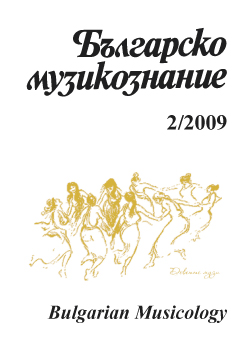Божидар Спасов: рефлексии върху българския неравноделен ритъм в „Пиериди”
Bojidar Spasov: Reflections Upon The Bulgarian Irregular Rhythms in Pieridi
Author(s): Angelina PetrovaSubject(s): Music
Published by: Институт за изследване на изкуствата, Българска академия на науките
Summary/Abstract: In the 1990’s and after the turn of the 21st century, Bojidar Spasov created a number of cross-cultural music projects. The cycle of nine compositions Pieridi is the earliest among them. The Bulgarian irregular rhythms in it are transformed into a symbol, provoking a distinctive picture of musical time. The composer reasons his own perception of time through the mystification of the argument between the Apollonian Muses and the Pieridi (primitive ancient Balkan muses). The irony is that the ancient Balkan layers, represented by the Pieridi, become to be perceived as new. After the composer, it is not a coincidence that the compound time signatures were absorbed by the Modernist’s rationality of the Western-European culture. In Pieridi Bojidar Spasov constructs micro-polyphonic textures consisted of intricate variants of irregular rhythms. These textures are provocatively unorthodox, compared to the well-known Post- Avant-garde micro-polyphonic models. In constructing the form, the composer uses simple numbers. His multi-layered technique is based on deformed rhythmic perception created by the displacement of 2’s and 3’s, played in very fast tempos. The poly-rhythmic and poly-metric effects are coming close to the unwritten polytempi of György Ligeti. In the described phenomenon, we discover a projection of flexible proportions of music time, known since the 14th century as Ars Nova techniques. The canonic forms of Spasov’s compositions are the most unorthodox part of his project. These unusual canons, based on irregular rhythms, are a collision of simultaneous proportions. For Bojidar Spasov the canonic nature of his work echoes Shopi (a region around Sofia and the adjacent areas) vocal tradition, embedded into unusual combinations of asymmetrical models, which can color and paradoxically unveil the different layers of monody. The irregular canonic structures are a separate problem. Here must be emphasized the interaction of the incommensurability of the structures’ and the voices’ time reflections or in other words, the simultaneity of the dissimilar. Canonic structures of this kind are encountered in composer’s Concerto for Oboe. In the piece for tuba from Fiato continuo, the perception of time as simultaneity (transformation of time layers/ reflections), is recreated as a canon between the solo instrument and the layer of electronically deformed shady voices.
Journal: Българско музикознание
- Issue Year: 2009
- Issue No: 2
- Page Range: 65-83
- Page Count: 19
- Language: Bulgarian
- Content File-PDF

